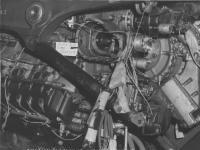



The Junkers Jumo 213 Engine
by Doug Culy
Published 4 April 2012; Revised: 15 March 2016
This same article with high-resolution images is available in the Members Section
 |
 |
| Focke-Wulf 190D-9 (NMUSAF) | Junkers Jumo 213 Right Side (NMUSAF) |
 |
 |
| Junkers Jumo 213 Underside (NMUSAF) | Junkers Jumo 213 Right Aft (NMUSAF) |
T.jpg) |
T.jpg) |
T.jpg) |
T.jpg) |
| Junkers Jumo 213 A-G1 (Wikimedia Commons) | Junkers Jumo 213 A-G1 (Courtesy of Evzen Vsetecka) | Junkers Jumo 213 A-G1 (Wikimedia Commons) | Junkers Jumo 213 A-G1 (Wikimedia Commons) |
The Junkers Jumo 213 engine was the powerplant of the Focke-Wulf 190D fighter, and the Junkers 88, 188 and Heinkel 111 bombers in the last year or so of World War Two (WW2), as well as for several late bomber and fighter developments. It was designed to replace the Jumo 211 engine, and was the last in the line of liquid-cooled inverted V-12 engines produced by the Junkers Motors Division from 1933, although newer designs were tested on the ground and in flight. The Jumo 213A at 1,750 shaft horsepower (shp) (the goal was 1,850 shp) was a beefed-up and speeded-up version of the Jumo 211F 1,340-shp 12-cylinder engine (same 5.9-inch bore and 6.5-inch stroke, for 2,136 in³ displacement). It is known to have been running by the start of 1938 [Green, 1979], and was first flown in Ju 88B V-28 before July 1941 [Kay, 2002]. Because the Jumo 213 was conceived as a bomber engine, it was thought to be too large for a fighter, and it was not until spring 1942 when the Jumo 213 first powered a Fw 190D in flight. No engine historians have told us when the program was started except that Gunston says studies were under way when the WW2 started in September 1939. However, Green says that the Jumo213 along with the radial BMW 139 (first run in the spring of 1937) were together considered for versions of the Ju 88 in 1939 when both were at 1,500 shp, just before the BMW 801 became available. The BMW 139 was begun in 1935 with an RLM (Reichluftfarhtministerium – German Air Ministry) order [Dymock, 1990], which Junkers surely knew about. Junkers later studied the Ju 87F (not proceeded with) with use of the Jumo 213. The BMW 801 resulted in cancellation of the BMW 139 on June 30, 1939; but, the BMW 139 powered the Fw 190 V-1 and V-2 and the Dornier 217 V-6. The above events define the origin of the Jumo 213.
The Initial Operational Capability of the high-altitude Spitfire IX in July 1942 allows us to infer that Germany anticipated needing high-altitude fighters and bombers several years before, and took action to get more powerful high-altitude engines (having started high-altitude research in the early 1930s). Also, given that competing companies tend to hear what is going at each other’s shops, we can speculate that Junkers was motivated to get more horsepower when they heard that Daimler-Benz had self-funded the start of the 1,510-shp DB 603 program, which produced 1,750 shp at MQT (Military Qualification Test — used to qualify for production)) in 1936. The DB 603 was first run in March 1939 after having been temporarily cancelled by the RLM in 1937. Also in 1941, the DB 603 was temporarily ‘out of favor’ with the RLM and seen as not having a medium-altitude-capable engine ready as soon as the Jumo 213 was expected to have it. Therefore, the RLM selected the Jumo 213 for the Fw 190D, against Focke-Wulf’s preference.
Another driving factor was the RLM’s Bomber-B competition, which began in July 1939 and specified three engines. All were risky new developments of unusual configuration, having a goal of 2,500 shp — the Jumo 222 and 223, and the DB 604. None of these reached production. Since Junkers was basically a conservative organization, they were motivated to continue work on a more easily obtained lower-horsepower engine, which would have the potential to yield 2,500 shp through additional supercharging, higher compression ratio, and higher rotating speed.
Significant for the Jumo 213 was cessation of Jumo 211 production in August 1944; but over-production had left several thousand uninstalled engines [Vajda, 1998], and probably forced any new airframe production previously based on the Jumo 211 to use the Jumo 213.
The DB 603 was a bigger engine, 2,717 in³, than its predecessor, the 2,069in³ DB 601, and produced 1,800 shp by 1943. Junkers approach was to speed up the Jumo 211 from its later versions’ speed of 2,600 rpm, to an initial 2,900 rpm at the Preliminary Flight Rating Test (PFRT) and then increase it to 3,200/3,250 rpm by MQT. Ultimately, the Jumo 213J was rated at 2,400 shp at 3,700 rpm; quite fast for an under-square engine with 5.90-inch-diameter pistons. Conservative design principles meant that many engine components had to be strengthened to enable this increase in rotating speed. Engine weight for the single-stage-supercharger versions increased from 1,408 pounds for the Jumo 211 to 2,024 pounds for the Jumo 213, an over 40% increase for no increase in piston displacement. Flywheels were added to the camshafts to offset cam lobe eccentricity. The larger DB 603 actually weighed less, at 2,002 pounds, confirming the conservatism in the Jumo 213’s design.
Vajda also indicates that 74 Jumo 213 engines were “produced” in 1942, none earlier, and 477 built in 1943. It is likely that the 74 1942 engines were intended for prototype airframes, but not the experimental ground-test engines. In which case, the number of ground-test engines is probably at least 30, and possibly 50. Note: the reason for such a large number of test engines is the need to accumulate the largest amount of engine test hours in the shortest time; this being to find and fix the parts most prone to failure. The probability of finding weak parts is directly related to the number of total hours run, whether on one or many engines, per the Weibull probability distribution function. This is a separate consideration from wear-out, which defines durability. In addition, since the Ju 88 data indicates the Jumo 213 was flown by July 1941, working backward, it is likely that the program was started before 1939. Considering that it took a little over three years to develop the Jumo 211, a scale-up of the Jumo 210; and the Jumo 213 development challenge being about the same as that of the Jumo 211; estimating the same time for developing the Jumo 213 is a reasonable assumption.
The first powering flight of an aircraft engine is a very significant event, as it signals that the engine has demonstrated sufficient reliability and durability in ground testing via the PFRT that it can be trusted for the safety of the pilot and airframe. Gersdorff and Nowarra2 say that five 100-hour maximum-power tests were run to qualify the engine for production, the last probably being completed in February or March 1943, because large-scale production go-ahead was given about then. Before WW2, normal practice in the engine industry had been to use one 50-hour maximum-power run for production qualification. Demand for greater useful life was forcing practice to 75- and 100-hour test runs. Therefore, it is highly probable that the last four of those 100-hour runs were needed to re-qualify a major part redesign after a test failure; i.e., there were four significant failures during qualification tests. This is not unexpected in the situation of a 40-plus-percent increase in rotating speed, and it took about two years for this to happen; i.e., that much delay from original plans for Jumo 213 certification.
Looking at the first flights of the aircraft with Jumo 213 engine power further enhances understanding of the engine program. All indications are that the Fw 190D was the second to fly with the Jumo 213 engine, and by a large time margin relative to the other aircraft that it powered in 1943, 44, and 45. This is strange since the Jumo 213 has always been described primarily as a bomber engine. The most authoritative sources say that first Fw 190D flight was that of the V-17 prototype some time between March and September 1942. The V-17, Works No. 39, was built in the late summer or early fall of 1941 as part of the first batch (40) of A-0 airframes [Smith, 1973]. It is interesting to note that in spite of this modest agreement by Focke-Wulf historians, it is a fact that the RLM issued Focke-Wulf a contract in October 1942 for a mock-up of the Jumo 213 installation in the Fw 190. This may have been for the “power-egg” form of the Jumo 213, since it appears that Focke-Wulf had already installed the engine in the V17.
When Focke-Wulf decided to pursue higher altitude capability for the Fw 190, they simultaneously embarked on a three-pronged program for the B, C, and D versions, pursuing: (B) nitrous-oxide-injecting the BMW 801 engine of the “A” versions, (C) turbocharging the DB 603 as a new installation, and (D) accepting the Jumo 213 for medium altitude operation, also a new installation. Prototypes V-13 through -22 were initially set aside for this role, apparently simultaneously, and airframe work numbers correspondingly set aside from the pre-production batch, A-0s. Turbocharging proved to be not feasible for large-scale production because of the unavailability in Germany of the requisite metals for turbines [Nowarra, 1980]. The DB 603 needed turbocharging because at that time it did not have adequate impeller gearing to allow higher supercharger speed at higher altitude; nor was a second supercharger stage ready for production at that time. The DB 603 was also heavily committed to other programs, so the RLM selected the Jumo 213 for the Fw 190D.
There is confusion about when this happened, as the V-17 was initially set aside for the “C” effort, to receive a DB 603. With that engine’s shortcomings, the “C” program was cancelled and V-17 was stored, without a DB 603 ever having been installed, until availability of the Jumo 213. How long that storage was is not known, and historians give dates varying from March 1942 to March 1944 for Jumo 213 installation (a huge range of uncertainty). The next Fw 190s to fly with a Jumo 213 were the V-53 and V-54, again with uncertainty about dates. It was most likely before the summer of 1944, the date they appeared at Focke-Wulf’s flight test center at Langenhagen, after having been assembled in Bremen. There is a strong implication that the early availability of the Jumo 213 for V-17 was because Focke-Wulf had very good connections with Junkers Motors and the RLM. At that point in time (early 1942) the RLM’s priorities were not as high as they were a year later for performance at higher altitudes. In August 1944, production of bombers was stopped, and Jumo 213 production was then available for the Fw 190.
Both the Jumo 213 and the DB 603 had initial reliability/durability problems, and the DB 603 actually became available for production sooner than was the Jumo 213. But, the DB 603 was in high demand, and the RLM stuck to the choice of the Jumo 213; but Kurt Tank, Fw190 designer, clung to the idea of using the DB 603 in the Fw 190 airframe for the rest of the war. He installed it in the last version of the Ta152.
The latest likely program start date is the spring of 1938. So the significant 213 program dates are probably:
| Studies: | Spring 1936 ~ 1937 |
| Kickoff: | Early 1938 |
| First Run: | Early 1939 or late 1938 [Green, 1979] |
| Announced (with BMW 139): | Proposed for Ju 88B late 1939 |
| Production Order: | Middle 1942 or earlier |
| First Flight: | July 1941 or earlier [Kay, 2004] |
| Production Qualification: | Spring 1943 (delayed two years) |
| Hopefully, a reader will be able to tell us how it really happened. | |
Other aircraft first flights with the Jumo 213 were: Junkers Ju 88S-3 in early 1943, Ju 188A in February 1943 (original planned service entry was 1941), the Focke-Wulf Ta 154 in November 1943, Messerschmitt Me 209V6 in May 1944, Ju 388L3 in late 1944, the Heinkel He 111H-21/23 also in early 1944 (installation of the Jumo 213 and DB 603 in the He 111 was studied in 1941, but postponed by unavailability of both engines), and the Dornier 335 V-7 in summer 1944 [Green, 1979]. A total of 9,163 Jumo 213s were built in Germany, and it was continued in production by the French after the end of WW2 as the Arsenal 12H line (see Jane’s 1952 All the World's Aircraft) which says something about the relative value of the Jumo 213 versus the DB 603.
New aircraft absorbed Jumo 213 production approximately as follows:
| Aircraft Designation | Aircraft with Jumo 213s |
Engines |
| Focke-Wulf Fw 190D/Ta 152 | 900 | 900 |
| Junkers Ju 88G and S | 500 | 1,000 |
| Junkers Ju 188A (majority Jumo 213) | 950 | 1,900 |
| Focke-Wulf Ta154 (half with Jumo 213) | 60? | 120 |
| Messerschmitt Me 209V-6 | 1 | 1 |
| Junkers Ju 388 (minority Jumo 213) | 50? | 100 |
| Heinkel He111-H21/23 | 500 | 1,000 |
| Dornier Do 335 V-7 | 2 | 2 |
Therefore, of the 9,000+ Jumo 213s produced (2,681 in 1945 [Vajda, 1998]), new installations accounted for a little over 5,000, leaving about 4,000 for replacements. This is about 0.9 replacements per airframe. Average life per engine was about 50 hours, suggesting that the average airframe lasted about 60 flight hours.
Via impeller gearing, the Jumo 213 was found to be more effective as a fighter engine than the DB 603, largely because it retained performance to a higher altitude than did the DB 603. Both were single-stage, two-speed supercharged engines in early production form. The DB 603 had greater displacement and could therefore breathe more air than the Jumo 213. By running faster, the Jumo 213 would be expected to have reduced volumetric (breathing) efficiency at its higher speed for rated power. Perhaps the Jumo 213 had greater valve area, although the Jumo 213E had a two-stage, three-speed supercharger, which would certainly offer better high-altitude performance than a single-stage and/or two-speed version. later Jumo 213s had two-stage, three-speed superchargers, while later DB 603s had variable-speed supercharger drives. The Jumo 213 had a three-valve head, but a four-valve head was in development for the “J” version. However, the Jumo 213A is documented as having superior high altitude performance at that particular point in time, although the DB 603 was later developed with equal or better features. In any event, the proof of its superiority among the piston engines of the war is that the French continued its production, ranking it with the handful of piston engines to complete the transition to the jet over the next fifteen years.
References
The references below are ranked in order of their contribution to this story.
German Aircraft Industry and Production 1933-1945, Ferenc J. Vajda & Peter Dancey, Society of Automotive Engineers (SAE), Warrendale, 1998.
Warplanes of the Third Reich, William Green, Doubleday, Garden City, 1979.
Junkers Aircraft and Engines 1913-1945, Antony L. Kay, Putnam, London, 2004.
Flugmotoren und Strahltriebwerke, Kyrill von Gersdorff & Kurt Grasmann, Bernard & Graef, Koblenz, 1985.
German Aircraft of the Second World War, A.L. Kay, Putnam, London, 2002.
Focke-Wulf 190 - Production Line to Frontline, Malcom V. Lowe, Osprey, Wellingborough, 2003.
Focke-Wulf Fw 190 and Ta 152 – Aircraft Legend, Heinz J. Nowarra, Haynes, Yeovil,
1988.
Focke-Wulf – An Aircraft Album No. 7, J. Richard Smith, Arco, NYC, 1973.
The Focke-Wulf 190 – A Famous German Fighter, Heinz J. Nowarra, Harleyford, Letchworth, 1965.
Junkers Ju 88, Ron Mackay, Crowood Press, Ramsbury, 2001.
Heinkel He 111 A Documentary History, Heinz Nowarra, Janes, New York, 1980.
Monogram Close-Up 22 – Moskito, Jay P. Spenser, Monogram Aviation Publications. Boylston, 1983.
Major Piston Engines of World War II, Victor Bingham, Airlife, Shrewsbury, 1998.
World Encyclopedia of Aero Engines, Bill Gunston, Patrick Stephens, Wellingborough, 1986.
Hitler’s Luftwaffe, Tony Wood and Bill Gunston, Salamander Books, London, 1997.
BMW: A Celebration, Eric Dymock, Orion Books, New York, 1990.
Jane’s All the Worlds Aircraft 1952-1953.
Additional Junkers Jumo 213 Images from the National Museum of the USAF
 |
 |
 |
 |
 |
 |
 |
 |
 |
 |